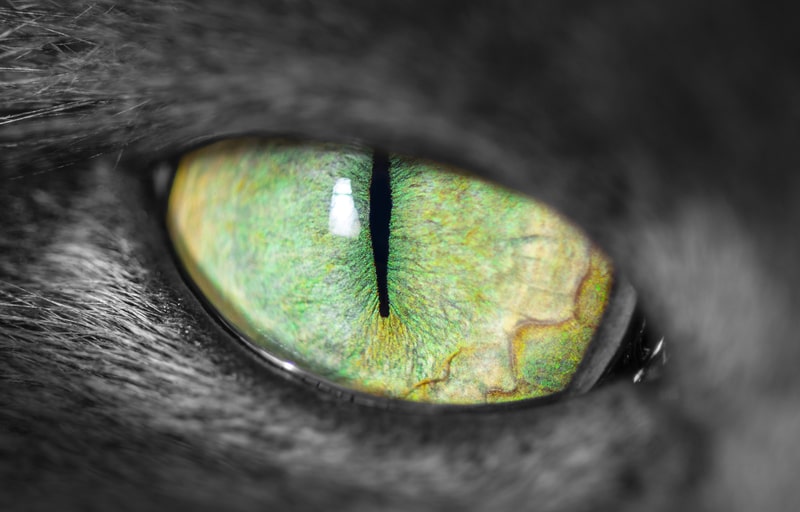Last updated on April 30th, 2023
Tigers are regal, magnificent creatures and are the most diverse cat on the planet. Although tigers are incredible animals, you won’t want to come face to face with one unless there’s a strong fence separating you from the tiger. Many people group tigers in with the other big cats in the world, and this causes people to have misconceptions about tigers. We know that tigers are endangered due to the carelessness of humans, and there are many fascinating facts about tigers you may have never known about.
Interesting facts about tigers
1. Tiger’s Eyes
If you listen to the radio or have seen the Rocky movies, you’ve likely heard the song, Eye of the Tiger. This song is more about strength and will and less about tigers’ eyes. Domestic cats have slitted pupils because they are nocturnal animals, and their pupils help them see at night.
Tigers have round pupils because they are crepuscular animals, meaning they are primarily active during twilight periods. Tigers hunt in the early morning and the evening and often roam at night, and they can see in the dark and don’t need slitted pupils to see.

2. Tigers See Better Than Humans
Although tigers don’t have slitted pupils, it doesn’t mean they don’t have good vision at night. They cannot see better than domestic cats and other cats with slitted pupils and cannot strongly adapt to the dark; tigers still have excellent night vision, which is better than a human’s.
A tiger can see six times better in the dark than humans, which is necessary when living in the wild.
3. Tigers Were Around Millions of Years Ago
The Longdan tiger is the tiger’s oldest ancestor and walked the earth 2.55 to 2.15 million years ago. This tiger’s remains were found in China’s Gansu Province and were similar to the tigers that roam the world today. This tiger’s skull and teeth structure are similar to today’s tigers, but the Longdan tiger was smaller.
Scientists believe that the tigers got bigger as their prey got bigger.
4. Eye Color
Most tigers have yellow eyes; however, it isn’t uncommon to see a tiger with blue eyes. Only white tigers have blue eyes because the blue-eyed gene is liked to the white fur gene.
Blue-eyed tigers are often cross-eyed or boss-eyed, which is linked to white, blue-eyed tigers.
5. The King Of the Jungle
Lions are known as the king of the jungle, but technically, this is wrong. First, lions don’t live in the jungle, so how can they be the king? Next, tigers are bigger, heavier, and stronger than all other cats, including lions.
Tigers can grow to be 660 pounds and 110 inches long, which is about the size of a small car. Also, tigers actually live in the jungle of Asia, making them the true kings of the jungle.
6. Tigers Are Very Chatty Cats
When you ask someone what sound a tiger makes, they will probably make a roaring sound. When tigers do roar, they can be heard almost two miles away. What you may not know is that they communicate in other ways.
Tigers are known to groan, growl, grunt, hiss, snarl, and gasp.
7. Tigers Are Born Blind
When tiger cubs are born, they’re blind. They can’t see anything, so cubs rely on their hearing and sense of smell to find their mother and siblings in the den. Surely this is one of the interesting tiger facts that you can share with your friends.
The cub will open its eyes when they’re one to two weeks old and can see its family and the world. Domestic cats are also blind for the first two weeks of their lives.
8. Many Tiger Cubs Don’t Survive
You now know that tiger cubs are blind, but did you know that only a few survive? Tigers are blind for the first couple of weeks of their lives and rely on their mother’s scent to stay close. If a cub loses its mother’s scent, it can get lost and die due to cold or hunger.
Sadly, some tiger cubs are eaten by male tigers. Males will eat cubs, so the mother will be available for mating, which is awful and pretty crazy.

9. Tigers Are Great Swimmers
When you think about great swimmers, you think about Olympic swimmers or fish. While it may sound crazy, tigers are also excellent swimmers. They love to spend their time swimming and playing in rivers and watering holes, giving them a chance to cool off. If you see a tiger in a river, don’t panic.
Tigers are excellent swimmers and don’t even need water wings.
10. Tigers Can Punch Harder Than Mike Tyson
Most people look at a tiger and worry about its enormous sharp teeth. While the teeth be a problem if a tiger corners you, you should be more worried about their punch. Tigers have huge paws, and a tiger’s punch can kill an animal or a human.
If you’re lucky enough to be alive after taking a punch from a tiger, you’ll probably have a broken bone or two or three, and you should get away from the tiger as quickly as possible. A punch from Mike Tyson will do less damage than a punch from a tiger.
11. Tigers Can Run Fast
Most people know that cheetahs are the fastest big cats on the planet, but did you know that tigers are also really fast? Tigers use their strong legs to sprint short distances and can run up to 36 miles per hour.
If a tiger ever corners you, running won’t save your life. Tigers can run much faster than you and will catch up to you quickly.

12. Tiger Pee Smells Like Popcorn
Yes, you read that right. Tiger pee really does smell like buttered popcorn. Tigers are very territorial and often live solitary lives. A female tiger’s territory usually spans 7.7 square miles, while males span 23 to 39 square miles, and the male’s territory often overlaps with the female.
Tigers will scratch or pee on trees to mark their territory. The popcorn-smelling pee can tell a tiger the age, gender, and reproductive condition of the tiger who peed.
13. Tigers Don’t Purr
If you have cats, you know they purr when feeling happy and content. Tigers are big cats, so you expect them to purr, but they don’t. Tigers don’t purr because they’re never happy, and they have their own way of showing their happiness and comfort by squinting or closing their eyes completely.
When a tiger can’t see as well, it lowers the tiger’s defenses, showing they’re happy and comfortable and aren’t worried about a fight. If you’re cornered by a squinting tiger or the eyes are closed, don’t worry because they won’t attack and may want to be friends.
14. Tigers Have a Set of Fake Eyes
Did you know that tigers have regular eyes and also a set of fake eyes? This sounds crazy, but it’s true. The fake eyes are called ocelli and are white spots on the back of each ear. This makes predators and prey think the tiger is awake and watching, even when they aren’t. This is one of the coolest tiger fact that talk about a tiger’s ability to defend itself.

15. Tigers Can Live To Be 25 Years Old
The average life expectancy of a tiger is 20 to 25 years old, but many die before turning 20. This is the case if they’re living in the wild or captivity.
The oldest living tiger’s name was Flavel, and he lived to be 25 years old in a zoo in Tampa, Florida.
16. Tigers Hunt Alone
Tigers are carnivores, meaning they hunt for and eat meat. When tigers go hunting, they hunt alone either shortly before the sun rises or soon after it sets. They hunt for large animals, such as wild pigs, deer, and buffalo, and eat nearly 66 pounds of meat in every meal, equivalent to 120 hamburgers.
17. What Are a Group of Tigers Called?
Most people know that a group of fish is called a school, and a group of geese is called a gaggle. Did you know there’s a name for a group of tigers? Tigers in the wild are solitary animals, but they spend their time together in a zoo or any man-made environment.
A group of tigers together are known as a streak or an ambush. A mother tiger and her cubs are also called an ambush.

18. Tigers Have Excellent Table Manners
Tigers don’t sit at a table to eat, but they have excellent table manners. When most animals in the wild catch their prey, they keep the meal for themselves and will fight for their dinner if necessary.
Tigers are different. Tigers often share their meals with other tigers in the wild, and males often allow the females and cubs to eat before they start digging in.
19. Tigers Have Stripped Skin
We all know that tigers have striped fur, but did you know their skin is also striped? If you were to shave a tiger’s coat, you’d see stripes on the skin. This is because the tigers’ colored hair follicles are embedded in the skin.
20. Tigers Develop a Taste For Humans
This is probably the scariest fact on this list. Although tigers don’t usually view humans as prey, the tiger will attack if a human threatens the tiger or a mother’s cubs. When tigers attack a human, some can develop a taste for human flesh.
There was a female tiger who had to attack humans to protect her cubs, and began preying on humans exclusively, and was responsible for the deaths of at least 430 people. This is a sad fact about tigers.
21. Tigers Have Very Loud Roars
Humans and most animals have triangular vocal folds. Tigers have fat in the vocal fold ligaments and are square. The square-shaped vocal folds allow tigers to roar loudly, using less lung pressure, and a tiger’s roar is 25 times the volume of a lawnmower.
The low frequency is undetectable to humans but can paralyze humans and prey. They don’t use this power when hunting and save it for prey that starts fighting back.

22. Tigers Don’t Only Mate With Other Tigers
Female and male tigers mate and produce baby tigers known as cubs. Male tigers can also mate with female lions, creating hybrid cubs known as Tigons. This is the largest cat species and can grow larger than a lion, which is a mix of a male lion and a female tiger.
23. Tigers Do Great Bear Impressions
On the list of tiger facts, this one is unique since it talks about a tiger’s ability to attract prey. It’s not uncommon for bears and tigers to cross paths in the wild. Tigers who live in the same environment as bears will hunt and eat the bears. Tigers do a great bear impression to lure the bears to them. The bear will think it found a meal for itself, only to be attacked and become food for the tiger.
24. Tigers Have Impressive Short-Term Memories
Short-term memory makes it possible to remember changes that have occurred over a short period of time. Most humans have good short-term memory, but tigers have remarkable short-term memory.
Their short-term memory is about 30 times longer than a human, which isn’t good for you if you come face to face with a tiger. If you get away, the tiger will remember seeing you for quite a while and won’t give up until they find you or forget they saw you, which will take time.
25. Tigers Have Healing Saliva
If a tiger gets cut, they don’t visit Dr. Tiger because they can heal their wounds themselves. Tigers have antiseptic saliva and will lick their wounds to prevent infection.

26. How Do Tigers Kill Their Prey?
Tigers require large meals for energy, and female tigers need a large meal to reproduce. When a tiger spots its prey, it will leap out and grab the animal by its neck. If the tiger severs a main artery, it will bleed out in seconds, allowing the tiger to enjoy its meal. If the vein isn’t severed, the tiger will hold on while the prey thrashes and will die of strangulation.
27. No Two Tigers Have the Same Stripped Pattern
We have our own distinct fingerprints, and no two are alike. Tigers don’t have fingers, so they have no fingerprints, but the stripped patterns are unique.
No two tigers have the same marking, and every tiger is unique, just like our fingerprints.
28. The Sabre-Toothed Tiger Weren’t Tigers
The scientific name for a Sabre-toothed tiger is Smilodon, which means tooth like a double-edged knife. These prehistoric tigers had canine teeth that grew to almost 8-inches long. This “tiger” lived in North and South America and became extinct 10,000 years ago. The crazy thing is that the Sabre-toothed tiger wasn’t a tiger and belonged to a family of cat cousins called Machairodontinae.
29. Tigers Don’t Always Use Their Teeth On Their Prey
Tigers prefer to use their large teeth to kill their prey. However, there are times when a tiger will use its paws. One swipe from a tiger can be powerful enough to crush a bear’s skull or break its back. When the bear is subdued, the tiger will use its teeth to chew into the bear and have a nice meal.

30. Tiger Tongues are Similar To Cat Tongues
If a cat has ever licked you, you know that their tongues are rough like sandpaper, and tigers have the same type of tongues. The upper part of the tongue is covered with fleshy bristles that help when they wash themselves and comb their fur. You can take our word for it and shouldn’t seek out a tiger to lick you because you won’t be around to confirm if this is true.
31. Tigers Aren’t Always Black and Orange
When you think about tigers, you picture a black and orange animal. Although black and orange are the most common colors for tigers, some can have white, gold, black, and even blue coats.
32. The Hidden Symbol
Right above a tiger’s forehead is a grouping of stripes. The stripes resemble the Chinese character that means king. This has given the tiger a regal status, and the lion isn’t always the king, but we won’t be the ones to tell them.
33. Tigers Can Find Prey In the Water
Tigers love to swim, and they know how to find a good meal before they finish swimming. If a large crocodile bites down on a tiger during a swim, the tiger can blind the crocodile by striking it in the eyes.
When the crocodile is blinded, the tiger won’t try to bite its neck because the skin is too thick. Instead, they will flip the crocodile over, exposing its soft belly, making for a great meal.

34. Tigers See In Color
Many people believe that animals can’t see in color, but this isn’t true. The only animal that’s been confirmed to see in black and white is a fish called a Skate. This fish doesn’t have cones in its eyes, which are necessary to see in color, and Tigers have rods and can see in color the same way we can.
35. Tigers Have Large Brains
The carnivore with the largest brain is the polar bear, and the tiger is a close second. A tiger’s brain weighs around 11 ounces and is almost the same size as a chimpanzee’s brain. This could be why the tigers have a longer short-term and long-term memory than any other animal, including humans.
Also, tigers have a memory that is 12 times better than primates and several hundred times better than dogs and domestic cats. Among other tiger facts, this surely is the one to remember.
36. The Wild Tiger Population
Considering the size of our planet, you would think that there are hundreds of thousands of tigers in the wild. Sadly, there are only about 3,500 left, and many more live in captivity.
37. Tigers Are Essential For the Ecosystem
If there aren’t enough tigers, it can affect the balance of the ecosystem. Tigers are the top predator and eat herbivores. If there aren’t enough tigers, too many herbivores will eat all of the plants, which will destroy the environment.
Tigers can be scary, but we should appreciate what they do for our planet.
38. White Tigers Are Rare In the Wild
White tigers are beautiful creatures. They don’t have albinism and aren’t white to adapt to a snowy environment. The color comes from a genetic mutation, and for a female tiger to give birth to a male tiger, both parents must have the genetic mutation. In 1958, the last wild white tiger was shot. In 2017, a pale tiger was seen, but it wasn’t a white tiger.

39. Never Poach a Tiger In China
People poach tigers in China for traditional medicinal purposes, which is illegal. If you get caught poaching a tiger, you won’t lose your hunting license, go to jail, or get a fine. Poaching tigers in China is punishable by death, so you may want to think twice before hunting tigers.
40. Three Tiger Subspecies Are Extinct
Tigers are in trouble today, and three subspecies have gone extinct over the last 80 years. The Bali tiger was hunted to extinction purposely because they were considered evil.
The Javan tigers’ numbers started to dwindle when coffee and rubber plantations took over their habitat and have since gone extinct.
The Caspian tiger went extinct due to excessive hunting of the tigers and their prey.
Wild tigers are in trouble today and have been for some time. Over the last 100 years, the number of wild tigers in the world dropped from 100,000 to a mere 3,200. Sadly, there could come a time when there are no more tigers in the wild.
This concludes our list of fascinating tiger facts. Hope you have enjoyed reading it.


